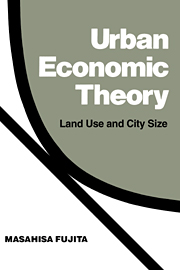Book contents
- Frontmatter
- Contents
- Preface
- 1 Introduction
- Part I Basic theory
- 2 Locational choice of the household
- 3 Equilibrium land use and optimal land use: single household type
- 4 Equilibrium land use and optimal land use: multiple household types
- 5 Urban aggregates and city sizes
- Part II Extensions with externalities
- Appendixes
- References
- Author index
- Subject index
5 - Urban aggregates and city sizes
Published online by Cambridge University Press: 23 December 2009
- Frontmatter
- Contents
- Preface
- 1 Introduction
- Part I Basic theory
- 2 Locational choice of the household
- 3 Equilibrium land use and optimal land use: single household type
- 4 Equilibrium land use and optimal land use: multiple household types
- 5 Urban aggregates and city sizes
- Part II Extensions with externalities
- Appendixes
- References
- Author index
- Subject index
Summary
Introduction
In the preceding three chapters, we examined the spatial structure of cities. We now turn our attention from spatial structure to urban aggregates. That is, within the same context of monocentric cities, we examine the relations among urban macrovariables such as the population, total income, total land rent, and total transport cost of a city. We also examine, in various contexts, the equilibrium city size and optimal city size. This chapter, therefore, provides a connection between urban land use theory and city-system theory. It deals with a simple case in which all households of the economy are assumed to be identical.
In the study of equilibrium and optimal city sizes, it is essential first to know why cities exist. Thus, in Section 5.2 we discuss various causes of urban agglomeration. In general, the equilibrium city size is determined at the intersection between the population supply curve and population demand curve of the city. And in determining the optimal city size, the surplus function of the city must be maximized. In deriving these curves and function, we need to know the relationships among economic aggregates in the city. Hence, in Section 5.3 we obtain some general accounting relationships among urban aggregates. Then, in Section 5.4, on the basis of these accounting relationships, we obtain the population supply function and population cost function. After these preliminary analyses, in Sections 5.5 to 5.7 we examine the equilibrium and optimal city sizes in different contexts.
- Type
- Chapter
- Information
- Urban Economic TheoryLand Use and City Size, pp. 133 - 174Publisher: Cambridge University PressPrint publication year: 1989



